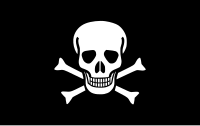You can help expand this article with text translated from the corresponding article in French. (January 2024) Click for important translation instructions.
|
| Death Squads | |
|---|---|
| Escuadrones de la Muerte | |
 Skull and bones flag, commonly associated with Latin American death squads during the Cold War. Skull and bones flag, commonly associated with Latin American death squads during the Cold War. | |
| Dates of operation | Early 1970s |
| Country | |
| Motives | Carrying out vigilantism and counterinsurgency against the Tupamaros and other left-wing guerrillas. |
| Ideology | Anti-communism Ultranationalism |
| Political position | Far-right |
| Major actions | Enforced disappearance Extrajudicial killing Extrajudicial punishment Torture |
| Opponents | |
| Battles and wars | Uruguayan intrastate war |
The Death Squads were a group of far-right paramilitary associations which carried out extrajudicial killings and other criminal actions in Uruguay in the years previous to the civic-military dictatorship. Their existence and power have been disputed.
Background
The Squads were not a unified group. The movement carried out its operations through different organizations and names, namely the Comando Caza Tupamaros, the Comando Dan A. Mitrione, the Defensa Armada Nacionalista, the Comando Armando Leses, the Brigadas Nacionales, the MANO and the Escuadrón de Justicia Oriental.
The main sources of information about the Squads are the "Actas de Bardesio" (lit: Proceedings of Bardesio), a document disclosed by the Tupamaros. The proceedings were written after the abduction of photographer Nelson Bardesio, an alleged member of the group who confessed the Squads' activities and motives. According to Bardesio, the Death Squads were a total of 5 groups and had the approval of the Ministry of the Interior. The Squads would have been organized and promoted by important politicians and military personnel. The proceedings also point to the involvement of Paraguayan and Brazilian citizens in the organizations. Bardesio would later deny his claims before the police and state he had spoken under psychological torture.
A policeman, Nelson Mario Benítez Saldivia, confessed his participation in the Death Squads during a parliamentary investigation on the subject in May 1972. Benítez claimed to have been recruited by Bardesio for a "commando" involved in "terrorist actions", of which he was informed at Buenos Aires. He resigned the project soon after understanding its full implications, and claimed to have been detained for some days afterwards. Nevertheless, Benítez stated he was not informed of the involvement of the Squads in extrajudicial killings, and claimed he could only learn of small-scale attacks against left-wing figures' homes in which nobody was harmed.
A 1972 declassified document from the United States Department of State stated that four Tupamaros had been killed by the Death Squads in the context of counterterrorist operations.
See also
References
- "¿Qué fueron la JUP y los escuadrones de la muerte? La extrema derecha en los 70". la diaria (in Spanish). 2019-01-19. Retrieved 2024-01-05.
- ^ Maiztegui Casas, Lincoln (2008). Orientales: Una Historia política del Uruguay (in Spanish). Vol. 4 (1st ed.). Montevideo: Editorial Planeta. pp. 18–20. ISBN 978-9974-643-70-3.
- "EEUU confirma la existencia del Escuadrón de la Muerte en 1972". LARED21 (in Spanish). 2009-09-17. Retrieved 2024-01-05.